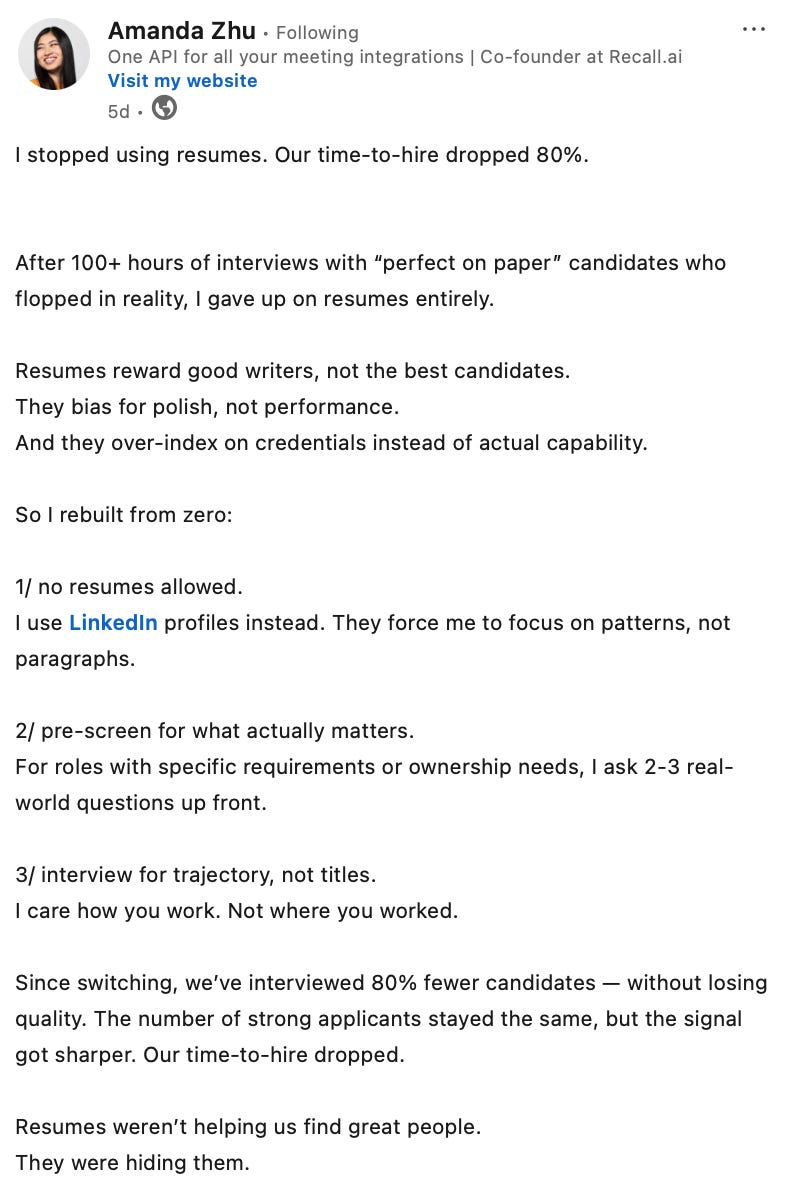Can AI kill the resume?
Jess has worked at (and hired for) some of the most prominent tech startups, including Airbnb, AngelList, and Watershed. This week, she breaks down why she doesn't over-index on resumes.
What’s the point of using “ex-Google” (or equivalent) on a resume or LinkedIn?
Asking this is a surefire way of stirring up debate on LinkedIn. Usually, people will jump in with comments like “get over your exes” or “this says nothing about an applicant”. While you can see a case for those comments, they ignore reality.
Whether we like it or not, “ex-Google” works pretty effectively. In the sea of noise that is LinkedIn and applicant tracking systems, it can be hard to find the “top” candidates.
As applicants, both of us have benefited from being “ex-Airbnb”. It hits the lizard brain pretty effectively (“if they worked at X, they must be decent”, or so the thinking goes). As hiring managers, we’ve learnt not to let the lizard brain take over.
The “ex-Google” trap and why it’s problematic:
Bias: When hiring from a pool of candidates who have only worked for prestigious brands, you’re inheriting the bias those brands have when hiring.
Fit: Just because someone was successful at Google doesn’t mean they’ll be successful at your company, especially if your startup has limited resources.
Depth: Having experience from a top brand doesn’t exclude a candidate from being good at their job, but it’s not enough to warrant hiring them. Interviews need depth.
The rise of AI makes this problem worse, not better.
If relying on prestige was a crutch before, it has the potential to become a full-blown dependency now. Resumes are more polished and keyword-optimised than ever before. Anyone can generate a beautifully written, applicant tracking system-friendly resume, regardless of whether the underlying experience backs it up.
That’s made the hiring process more overwhelming than ever.
When every resume starts to read well, hiring teams may fall back on what feels safe: recognisable names and logos. This could cause hiring teams to miss some of the best, high-slope candidates—the ones with steep growth curves or grit.
Here’s how AI may make the problem worse:
It amplifies existing bias: Most AI resume screeners are trained on historical hiring decisions, which often favour prestige. If your model learns that “ex-Google” resumes tend to get interviews, it will keep surfacing more of the same.
It encourages resume homogeneity: With tools like ChatGPT, resumes are starting to look identical and appear near perfect. This creates the illusion of competence, even when experience and skills are lacking.
It overindexes on keywords: AI often ranks candidates based on specific terms, which rewards those who optimise for buzzwords, not those who can do the job. The risk is that you pass on someone great who used different keywords.
We need better signals.
Leonardo da Vinci is often credited with the first documented example of a resume—a short letter to the Duke of Milan highlighting his expertise in engineering and architecture. But he didn’t list all his skills and experience; he tailored his pitch to match what he believed the Duke was looking for.
In that sense, not much has changed since 1482. Today’s candidates take a similar approach by adjusting bullet points, reframing responsibilities, or using strategic keywords on their resumes. But unlike da Vinci’s time, a resume today isn’t a personal letter; it’s a standardised document that the hiring manager often doesn’t see.
Most resumes are filtered through layers of software or busy recruiters, and as a result, candidates who don’t speak the correct language, haven’t worked at the “right” companies, or come from non-traditional backgrounds, don’t stand a chance.
Some teams are already skipping the resume entirely. Amanda Zhu, co-founder of Recall.ai, has discussed building teams without looking at a CV.
We need a new signal that’s not a resume proxy or a brand name shortcut—something deeper than a resume. It should help hiring teams understand what a person has done, how they operate, and their potential, without hours of prep from the candidate.
AI can help, but we shouldn’t replicate the existing hiring system. We don’t need better filters for keyword-matching resumes—we need to rethink the entire model. We need tools that surface real potential by analysing work samples, writing style, career trajectory, and peer endorsements, which can then be presented to a human decision-maker.
An AI plus human-in-the-loop system could help surface candidates based on their experience and trajectory. That’s the opportunity.
Wrapping up
I’m working with a small group of individuals who believe this is a problem worth solving, and it’ll take more than just better tools to do it. If you’re currently hiring for roles in product, let us know, and we’ll share more. We’ll share candidates who not only look good on paper but who have the credentials that your ATS is probably missing.
If that sounds interesting, drop a comment below or shoot over a DM on LinkedIn or Substack to Jess Toy.





